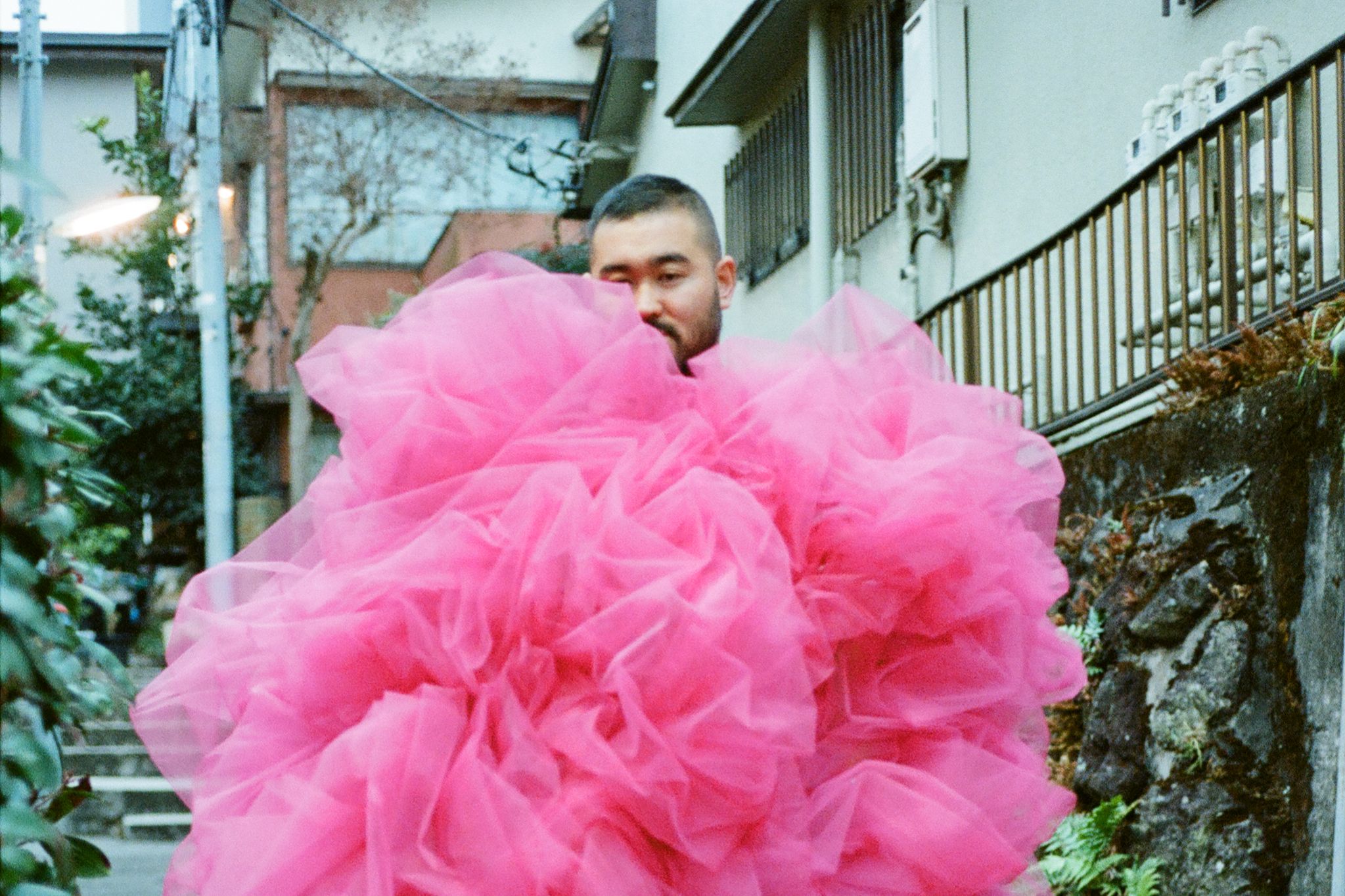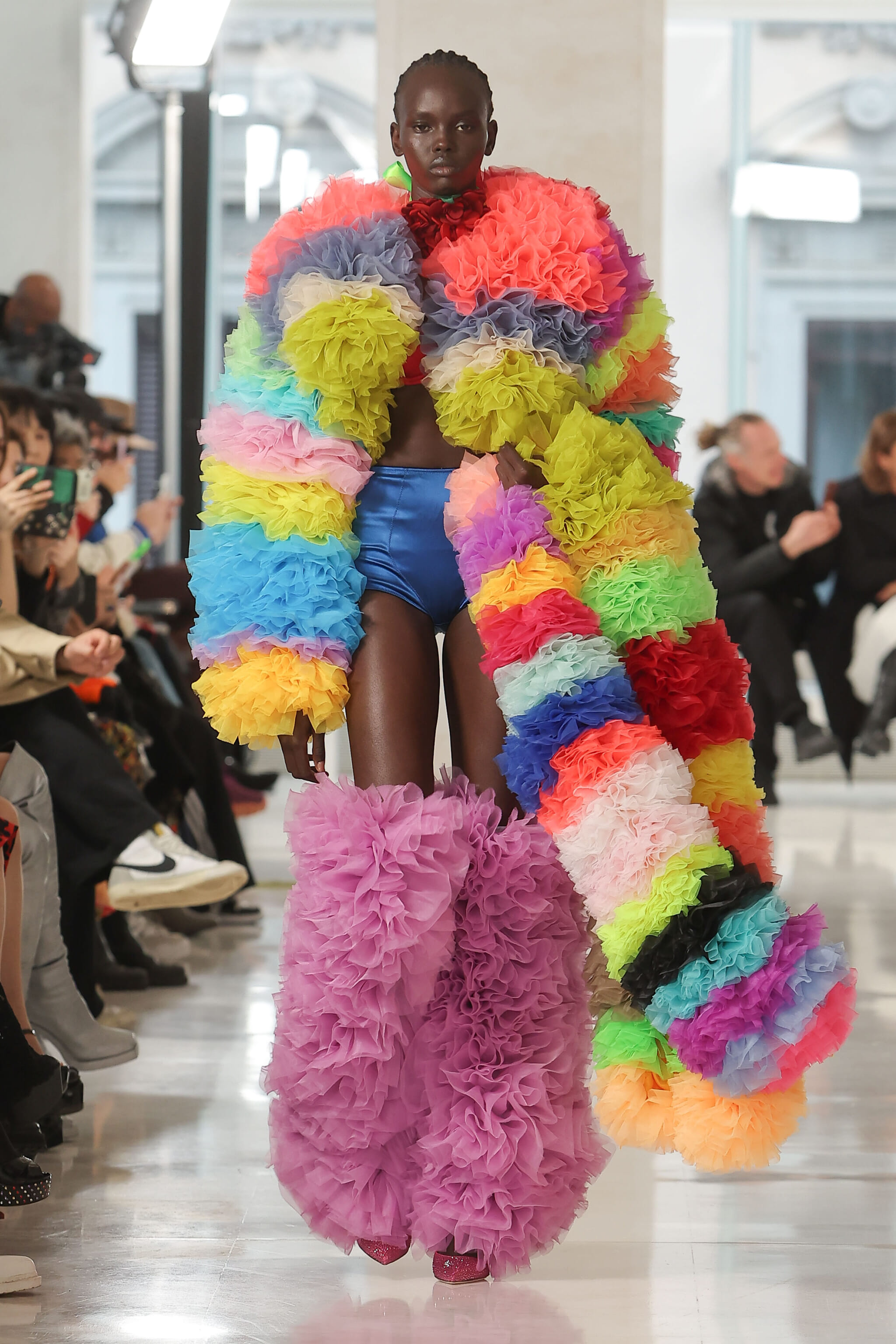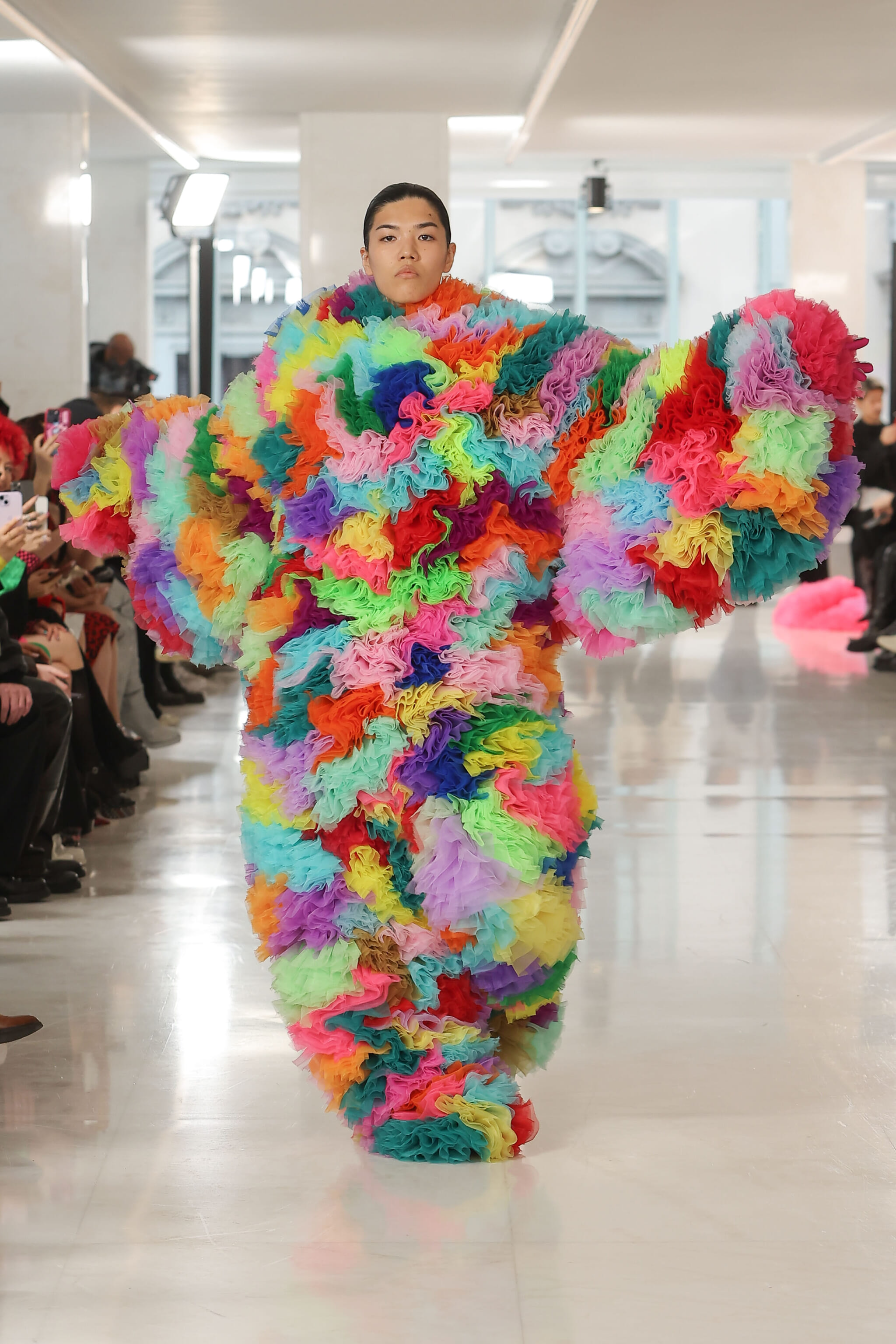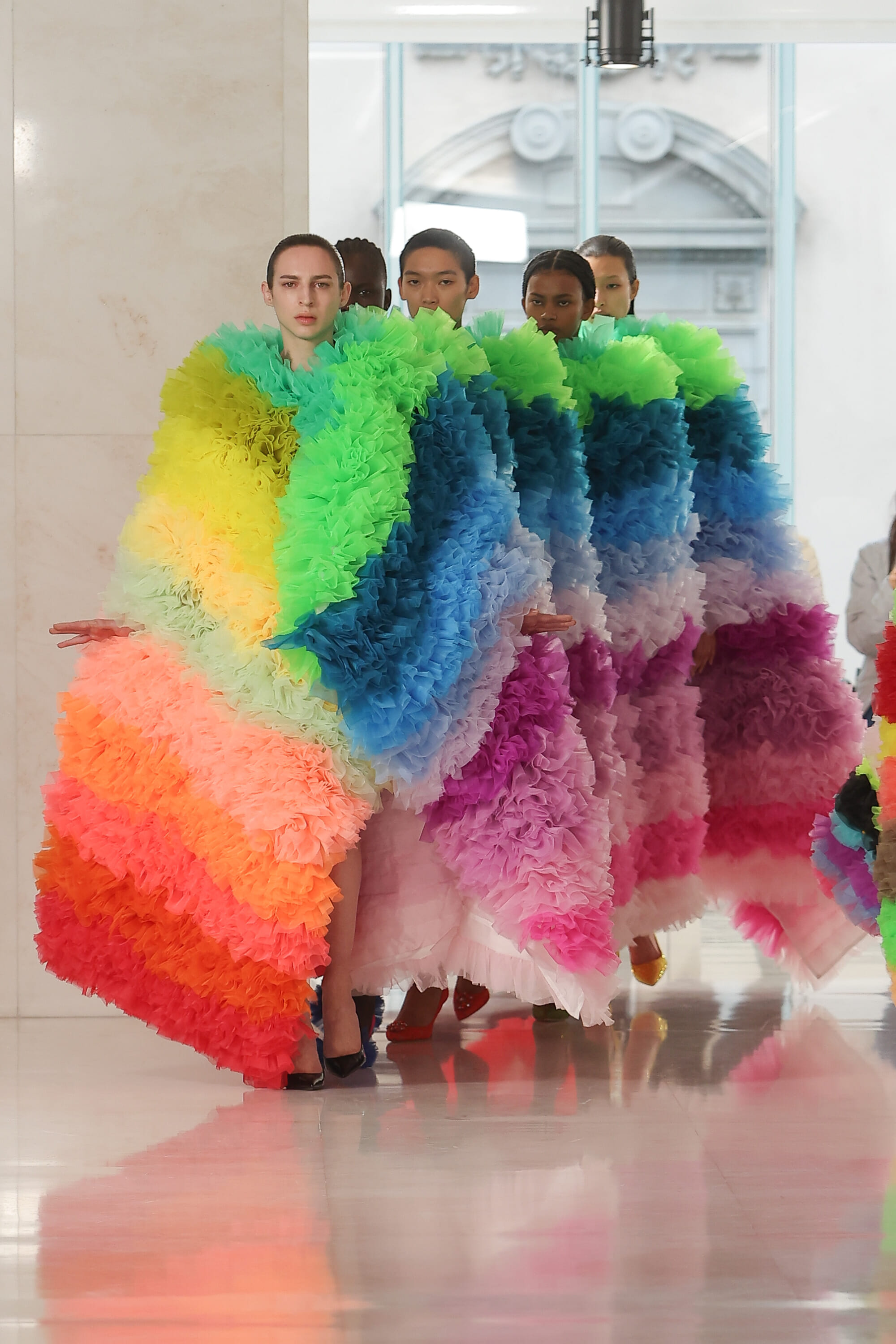Tomo Koizumi creates dresses. Dazzling dresses. Dresses worn by Björk and Lady Gaga. By nonbinary pop star Sam Smith and singer Rina Sawayama. By actor Gwendoline Christie and rapper Lil Nas X. The dresses in question? Giant, voluminous, outrageous.
The Tokyo-based designer shouts from Tokyo to the world, and has done so since 2019 when he was plucked from Instagram by the influential stylist Katie Grand. In a whirlwind three weeks, he went from Japanese costume designer to international celebrity dresser via his show, arranged by Grand, at New York Fashion Week. His first ever show outside Japan featured the likes of actor and essayist Emily Ratakojwski and models Bella Hadid and Joan Smalls. Since then, Koizumi has gone on to dress the biggest names in showbiz.
TW spoke to Koizumi the night after Björk’s Tokyo show, where the designer had dressed Kasimyn, Björk’s support act. (Björk herself wore a Koizumi dress for her 2021 performance).
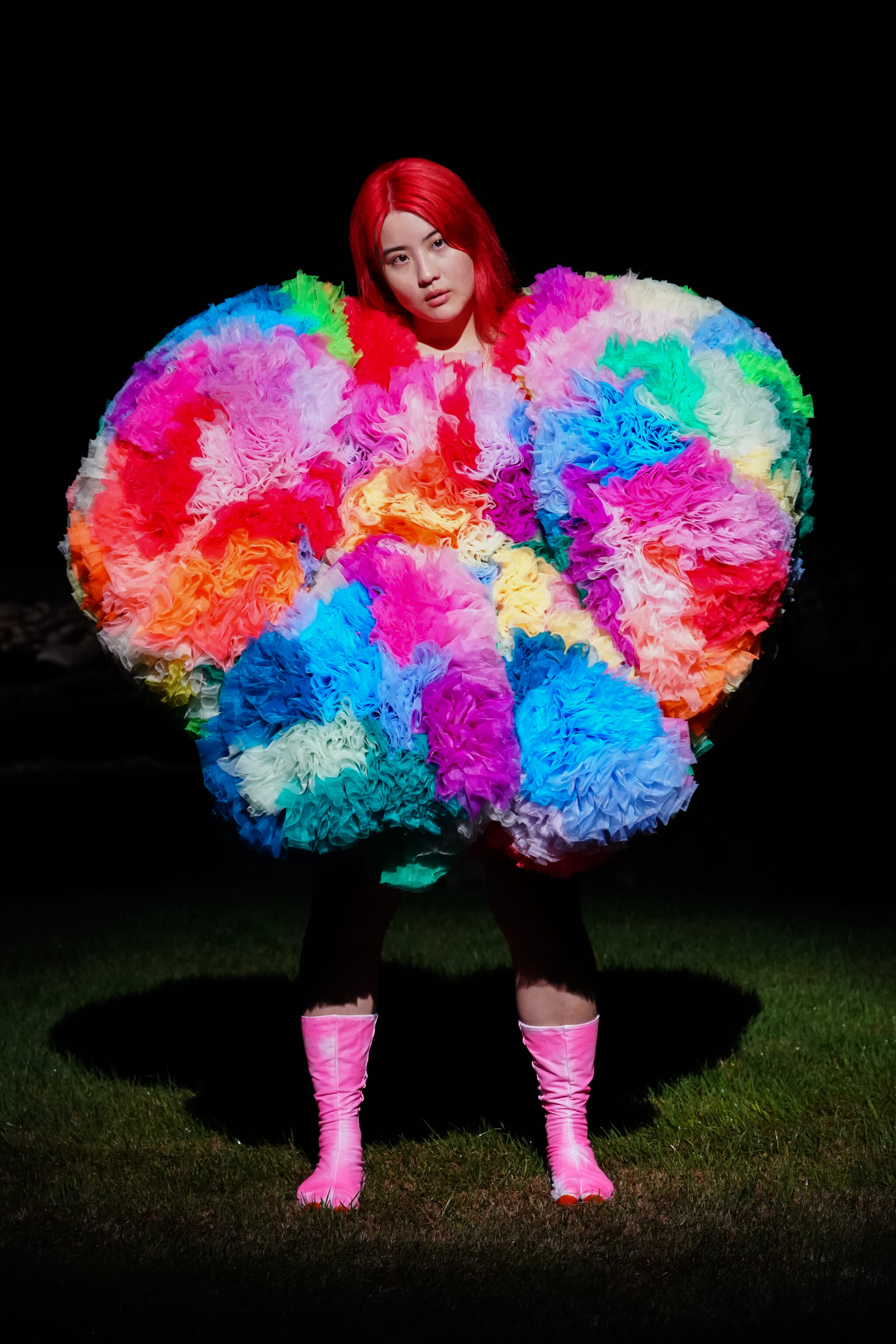
Model: Hibari
Originality in Design
Koizumi decided he wanted to be a designer after coming across a fashion magazine at the age of 14. He’d already been inspired from a young age by his fashion-loving mother, who dressed differently from the people around her in Koizumi’s hometown in rural Chiba. This pushed him to make his own clothing choices from elementary school, which led to both successes and the odd faux pas. “The trashiest things I wore,” Koizumi shares, “were probably tight, cropped T-shirts.”
Even though the cropped Y2K trend is back, Koizumi takes serious care when it comes to the newest fashions, but not for the reasons you might expect. “I always try to make sure I’m not following the trends when I design,” he says. As a keen proponent of slow fashion, he aims to create pieces with originality, adding that once you begin following trends with your designs, “you stick an expiration date on them.”
Koizumi’s designs are undeniably original; it could be said that he fashions talking points. “I create for those who can entertain with my dresses,” he comments, referring to people who will be looked at. His collaboration with Sam Smith sees the singer flouncing about in a magenta Tomo Koizumi dress in the video for “I’m Not Here To Make Friends.” In the video, the dress-clad Smith bursts out of a helicopter before being guided down a red carpet by drag queens.
Smith praised the designer in an Instagram post, writing that it had been a “true honor to wear his sensational work. … I’ll be forever grateful for this pink explosion.” Currently, a photo of Smith in the dress is pinned to the top of their Instagram page.
Koizumi tells me that the whole process came together smoothly. Smith’s stylist got in touch via email as Koizumi was preparing to show his latest collection at the Dolce & Gabbana headquarters in Milan. He made the dress to match Smith’s height — 188 centimeters — and sent it to Smith for the shoot. Then Smith’s team sent the dress back to show in Italy. “After Italy, I sent it back to them again,” Koizumi says. “I think they’ll use it for the world tour.”
The Stars of Diversity
Koizumi is nonchalant about working with celebrities, having dressed many of the biggest stars already, from Lady Gaga to Naomi Watanabe. Now, furnishing the rich and famous with fashionable attire is simply his day job.
When we ask if he has anyone else he’d like to dress, he seems bemused. “Well, I’ve already dressed Björk,” he says. “She was my top singer.” He thinks for a moment. “Maybe Beyoncé? Dua Lipa would be cool too.” We remark that he seems to like divas. “Yeah, divas,” he nods, considering the comment. “I do.”
Most of the celebrities Koizumi has dressed are connected to the LGBTQ community, which Koizumi is part of. Koizumi’s designs are often used by his clientele, from Smith, who identifies as nonbinary, to Lil Nas X, one of the few openly non-hetero rappers, to complement queerness or deviation from the norm. “I’m glad to be able to support members of the community with my designs,” he says.
Koizumi’s signature color palette is bright, each dress a flash of color. “I think of my dresses as rainbows, a symbol of the LGBTQ community,” he says. “They’re a way for people to come out.” Whether on the red carpet or otherwise, the dresses and occasional pink two-piece seem to fit members of the LGBTQ community particularly well, although Koizumi later remarks that the dresses suit anyone.
It’s not just members of the LGBTQ community, either. Koizumi is big on inclusivity. A recent show in Kyoto, for instance, featured predominantly Japanese and Asian models in a range of genders and body shapes, which was a conscious decision on his part. “I wanted to make a statement,” he says.
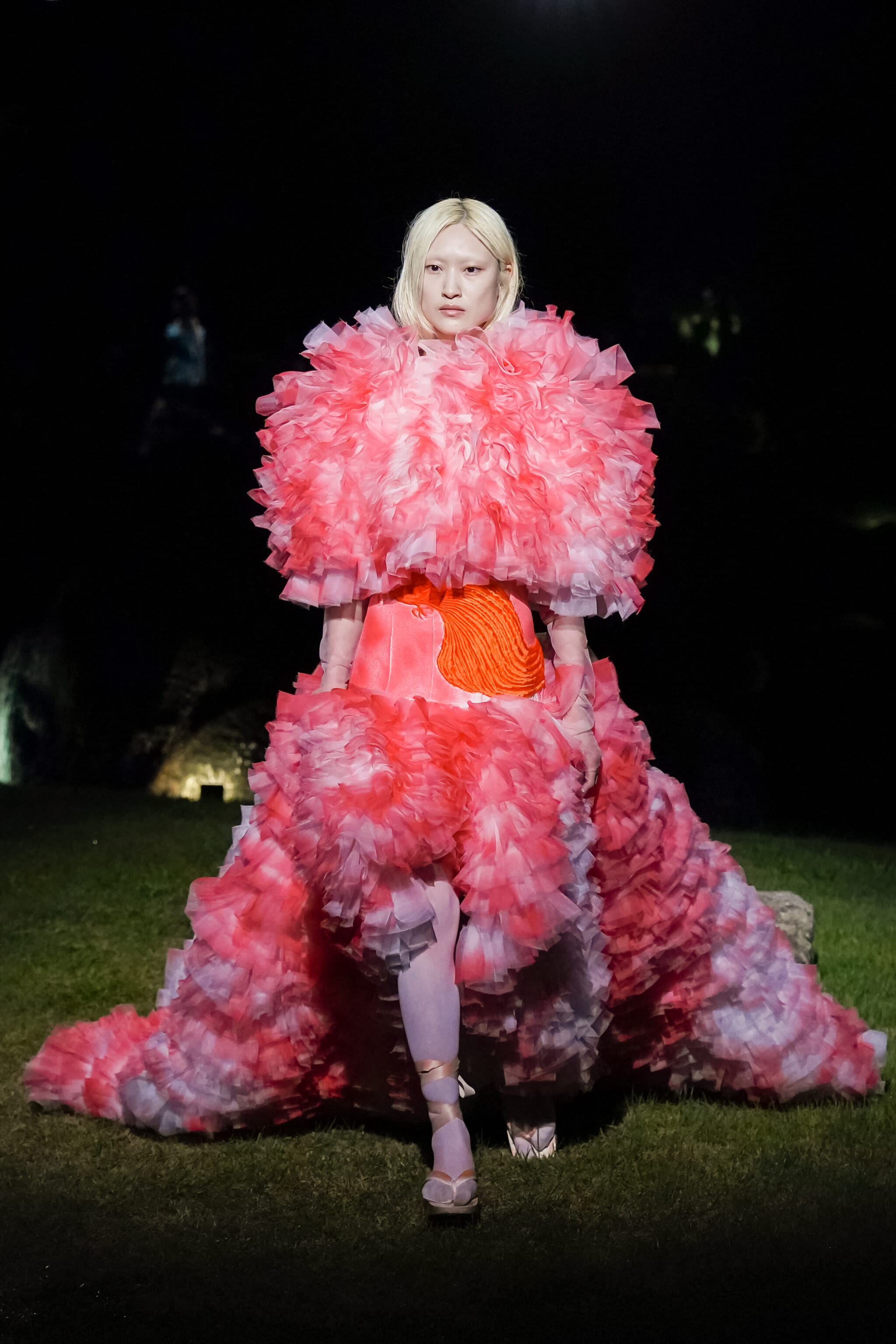
Model: Aoi Aoi
Championing Japanese Models
In Japan, there is a notable preference for white models on catwalks, despite the Japanese population being one of the most homogenous in the world. “It’s strange that the shows are for Japanese people, yet they hardly use Japanese models,” he says. “The audience can’t even see themselves in the looks. It’s an aspiration left over from the post-World War II era.”
Koizumi is cautious to maintain balance. His 2023 collection featured Japanese and Asian models and personalities, including Terrace House’s Lauren Tsai and previous TW cover star Yuki Matsuda. “I think (Japanese brands) using mainly white models makes the brand look a bit old-school. Although maybe that’s because Tomo Koizumi is for an international audience,” he says thoughtfully. “Perhaps because my first show was in New York, having inclusive casting just seems obvious.”
For the Kyoto show in 2021, which came at the height of COVID-19, he wanted to “bring hope,” and so he reached out to local Japanese craftspeople to incorporate Japanese motifs into the dresses using traditional embroidery techniques. Cranes flew across bodices as models of all shapes and sizes walked around Nijo Castle, their makeup done with nods to noh theater and geisha.
Koizumi was motivated to use traditional techniques for another reason too. “Cultural appropriation,” he says. “I think that young people can overreact, so to be on the safe side, I use techniques from Japan. I can’t steal from my own culture, right?”
Tokyo to the World
Koizumi still lives in Tokyo, a city that he feels is important to his identity. A well-known story is how he found organza to make his signature frills in a fabric shop in the Nippori district. Other videos online show the designer taking WWD magazine on a tour of his local area, Nakameguro. “Tokyo is so convenient,” Koizumi says. “If I want fabric, I can get anything really quickly. Same with research. Any fashion book I want is here.”
While his clothes are made for an international audience, he doesn’t see himself leaving Tokyo. “I think the best way for me is to make my works in Tokyo and present them in Europe and the U.S.”
Before the interview, I mentioned Koizumi to a Japanese friend who works in fashion. “There is nowhere in Japan for Japanese people to wear his designs,” she said to me, a statement I thought a bit harsh. On reflection, it seems that Koizumi himself somewhat agrees with the sentiment.
Sustainability
Toward the end of our chat, we talk about sustainability, something the designer regards as important. He makes his dresses as recyclable as possible by using 100% pure polyester or cotton. In turn, the polyester he uses is recycled.
In his recent Dolce & Gabbana show, Koizumi showed satin draping alongside his typical organza frills. The satin is made with a Japanese fabric called Renu, an innovative type of recycled polyester. But it’s not just about making dresses recyclable. The issue, he explains, lies in not creating in the first place, noting that he makes each dress to order.
There is one more reveal: For a pop-up in Osaka in 2021, Koizumi created a giant frilled wall for decoration. “This was the final look of my 2023 Milan show,” he shares. I remember the five models joined together, walking in unison, enveloped in a long, frilly dress, and it all makes sense. “I’m glad I kept that one.”

